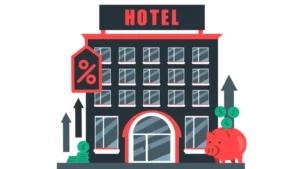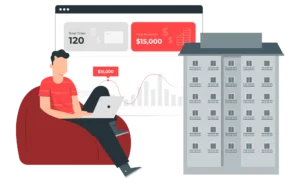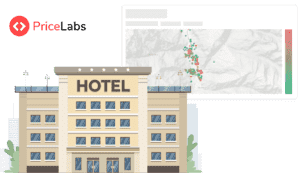Updated: April 2, 2024
In the world of hospitality management, understanding and effectively managing Hotel RevPAR (Revenue Per Available Room) is crucial for driving financial success and ensuring a property’s profitability. RevPAR is a key performance indicator, offering valuable insights into a hotel’s revenue generation capabilities. This comprehensive guide will delve into what Hotel RevPAR is and how it’s calculated and provide ten simple yet effective strategies for increasing it.
What is Hotel RevPAR?
RevPAR, short for Revenue Per Available Room, is a fundamental metric used in the hotel industry to evaluate a property’s revenue performance. It represents the total revenue generated from room sales divided by the total number of available rooms. By tracking RevPAR, hoteliers can assess their ability to effectively sell available room inventory at optimal rates, thereby maximizing profitability.


What is the Importance of RevPAR in the Hotel Industry?
RevPAR holds significant importance within the hotel industry for several reasons:
- Assessing Financial Performance: RevPAR is a key indicator for evaluating a hotel’s financial health and performance. By analyzing RevPAR, hoteliers can gain insights into their property’s room revenue-generating capability.
- Comprehensive Revenue View: Unlike other metrics focusing solely on occupancy or average room rates, RevPAR provides a comprehensive view of a hotel’s revenue performance by considering both factors. This holistic perspective enables a better understanding of overall room revenue generation.
- Informed Decision Making: Hoteliers rely on RevPAR data to make informed decisions to maximize profitability. Whether adjusting pricing strategies, allocating resources, or planning marketing efforts, RevPAR insights are crucial in strategic decision-making.
- Benchmarking Against Competitors: RevPAR facilitates easy benchmarking against competitors and industry standards. By comparing RevPAR metrics with those of similar properties, hotels can gauge their performance and identify areas for improvement. It is key to compare results with competitors because RevPAR is the comparable metric, regardless of the size of the hotel. Just comparing occupancy or ADR is not enough for hotels.
- Identifying Revenue Trends: Tracking RevPAR over time allows hotels to identify revenue trends and patterns. This insight enables proactive adjustments to revenue management strategies, helping hotels stay agile in response to market dynamics.
- Guiding Pricing and Revenue Management: RevPAR guides strategic pricing and revenue management efforts within the hotel industry. By optimizing room rates and occupancy levels based on RevPAR insights, hotels can maximize revenue potential while maintaining competitiveness.
- Supporting Investment Decisions: RevPAR data informs investment decisions and capital allocation within the hotel industry. Whether expanding facilities, renovating properties, or implementing new amenities, RevPAR serves as a valuable metric for assessing potential returns on investment.
RevPAR is important in the hotel industry as a comprehensive metric for assessing financial performance, guiding strategic decisions, and maximizing revenue potential. Its role in benchmarking, trend identification, and investment support underscores its significance in driving success within the hospitality sector.
Bonus Read: How to use PriceLabs for Hotels?
How to Calculate Hotel RevPAR?
There are two primary formulas for calculating RevPAR, both of which yield the same result:
- ADR X Occupancy Rate = RevPAR: This formula multiplies the Average Daily Rate (ADR) by the Occupancy Rate to determine RevPAR.
- Room Revenue / Available Rooms = RevPAR: This formula divides the total room revenue by the number of available rooms to calculate RevPAR.
Regardless of the formula used, RevPAR provides insights into a hotel’s revenue-generating efficiency and performance.
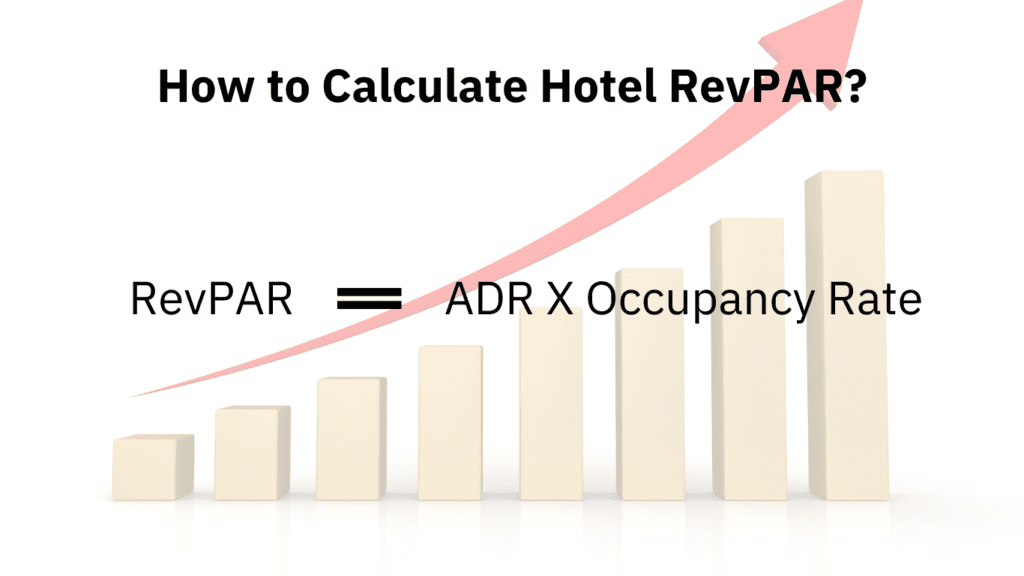

Bonus Read: How to Calculate Occupancy Rate?
What mistakes should be avoided when calculating Hotel RevPAR?
Avoiding mistakes in RevPAR calculation is crucial to ensure accurate insights into a hotel’s performance. Here are some common pitfalls to steer clear of:
- Neglecting additional revenue streams: Room revenue is essential, but don’t forget about other sources like amenities, in-room services, or hotel restaurants. Excluding these can underestimate actual revenue per available room.


- Failing to account for time periods: RevPAR can fluctuate based on the time of year or week. Analyze RevPAR within specific time periods to avoid misleading comparisons.
- Handling taxes and fees: Including all revenue, including taxes and fees, can inflate RevPAR figures. Subtract mandatory taxes and fees to reflect the hotel’s net revenue accurately.
- Mixing multiple properties: Calculate RevPAR for each property separately, considering their unique occupancy rates, room types, and revenue streams. Combining properties can skew performance analysis.
Does Hotel RevPAR Include Out of Order Rooms?
A common question in RevPAR calculations is whether to include out-of-order (O.O.O.) rooms. While some hotels exclude these rooms from the total available room count, others include them but without associated revenue. The latter approach offers a more accurate representation of RevPAR despite being a stricter calculation method. Hoteliers should carefully track trends related to unavailable rooms and adjust revenue strategies accordingly.
Analyzing & Tracking RevPAR
To effectively monitor RevPAR, hoteliers should regularly review revenue reports to identify any unexpected peaks or valleys in performance. Leveraging tools like property management systems, sales systems, or brand reporting can provide valuable insights into a hotel’s past performance. PriceLabs Portfolio Analytics is a free tool for hoteliers to analyze their booking trends and hotel data.
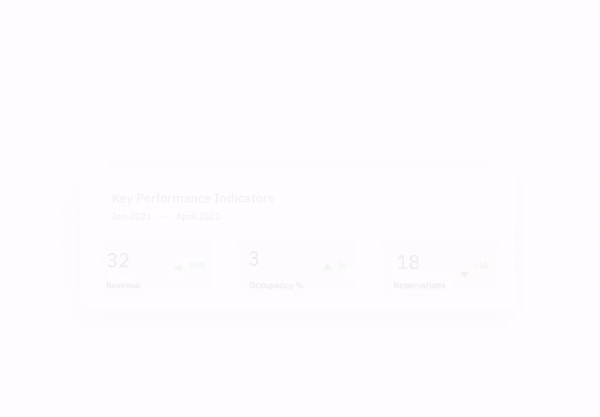

Booking Patterns:
Hoteliers should pay attention to booking patterns to optimize RevPAR. Identifying periods with a high number of single-night stays is crucial, as it may indicate a decrease in revenue potential. Conversely, periods with heavy multi-night stay patterns present an opportunity to adjust the Best Available Rates (BAR) to maximize future RevPAR potential. Using PriceLabs Listing Hotel Data, hoteliers can analyze the booking trends in their market and make informed pricing decisions.
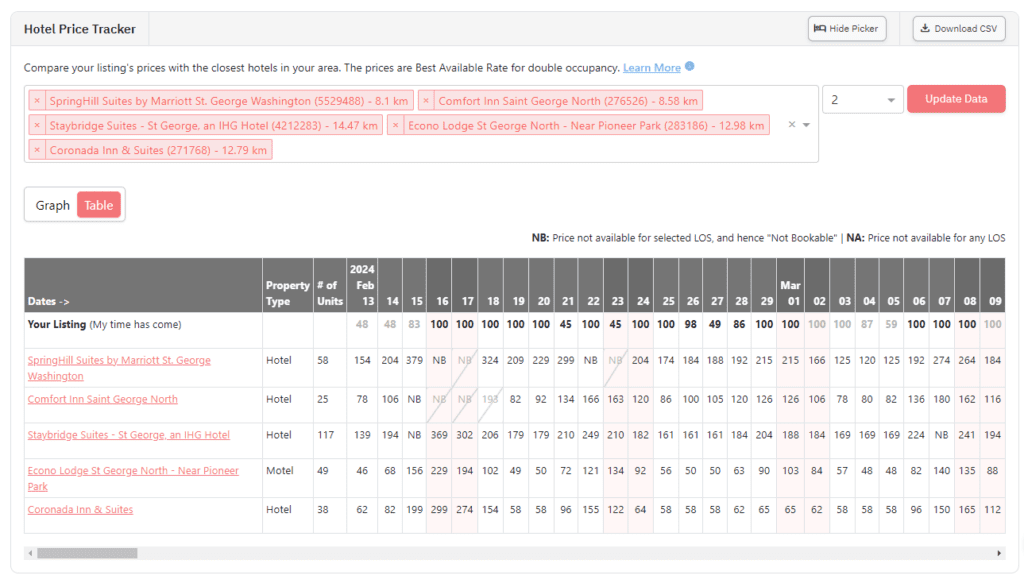

Market Segment Performance:
Analyzing the performance of different market segments can provide valuable insights into RevPAR optimization. Hoteliers should examine segments contributing to high RevPAR days, such as corporate travel or bookings through Online Travel Agencies (OTAs). Focusing on special event dates, consistent RevPAR spikes, and peak travel seasons is important for effective strategy development.
How to Set Hotel RevPAR Goals?
Setting achievable RevPAR goals is essential for driving continuous improvement and financial growth.
- Aim for incremental annual RevPAR growth, even if slight, to surpass competitors and achieve financial objectives.
- Assess growth potential realistically; for example, achieving a 6% year-over-year increase may be challenging without significant updates.
- Certain properties can substantially boost RevPAR with effective strategies depending on their market and amenities. In optimal conditions, hotels might even achieve annual increases of 5-10% or higher. Conversely, hotels located in oversaturated areas may struggle to achieve yearly growth rates of 3-4% or find it impossible to do so.
- Plan for rooms that are unavailable due to renovations or maintenance and consider their impact on revenue goals.
Hotel managers should understand past performance trends and anticipate future expectations to adapt revenue strategies effectively.
How to Create a Successful RevPAR Strategy?
Analyze and Monitor Market Demand
Understand market trends and demand fluctuations to make informed decisions. For instance, if your hotel is located in a tourist destination, analyze historical booking patterns to anticipate peak seasons and adjust pricing accordingly.
Optimize Pricing Strategies
Implement dynamic pricing techniques that align with market demand. For example, offer discounted rates during off-peak periods to attract budget-conscious travelers while increasing rates during high-demand periods such as holidays or special events.
Enhance Revenue Management Practices
Develop accurate forecasting models and utilize revenue management software to maximize revenue opportunities. If historical data shows higher demand for suites during weekends, adjust pricing and inventory strategies to capitalize on this trend.
Improve Operational Efficiency
Streamline operations and reduce costs without compromising guest experience. For instance, invest in energy-saving initiatives such as LED lighting or smart thermostats to reduce utility costs while maintaining guest comfort.
Enhance Guest Experience
Focus on providing exceptional customer service and personalized guest experiences. To enhance their stay, offer personalized welcome amenities or upgrades based on their preferences. This results in customer satisfaction, better reviews, and willingness to pay more for the stay (perceived quality vs price point).
Implement Effective Sales and Marketing Strategies
Develop targeted marketing campaigns and utilize digital marketing channels to increase brand visibility. Partner with local attractions or businesses to offer exclusive packages or discounts to attract more guests.
Optimize Distribution Channels
Evaluate distribution channels and centralize inventory and rates. Utilize a channel management system to adjust room rates dynamically across different channels, ensuring consistent pricing and availability.
Utilize Revenue-Generating Amenities and Services
Identify profitable amenities and develop attractive packages, such as spa packages or dining credits bundled with room bookings, to upsell additional services and boost RevPAR. TRevPAR, or Total Revenue Per Available Room, assesses the total income generated by a hotel per available room, including revenue from all departments.


Focus on Repeat Guests and Loyalty Programs
Develop a comprehensive loyalty program to reward repeat guests and encourage referrals. Offer incentives such as free room upgrades or loyalty points for future stays to incentivize repeat business.
Embrace Technology and Data Analytics
Utilize technology solutions and data analytics tools for data-driven decision-making. For instance, leverage AI-powered analytics platforms to analyze guest booking patterns and preferences, enabling targeted marketing campaigns and personalized offers.
Key Takeaways
- RevPAR Significance: RevPAR is vital for evaluating a hotel’s financial performance, guiding strategic decisions, and maximizing revenue potential.
- Calculation Accuracy: Avoid common RevPAR calculation mistakes such as neglecting additional revenue sources, ignoring room types, and mixing multiple properties.
- Goal Setting: Set realistic RevPAR goals considering market demand, growth potential, and property-specific factors.
- Strategic Approach: Develop a successful RevPAR strategy by analyzing market demand, optimizing pricing, enhancing revenue management, improving operational efficiency, focusing on guest experience, implementing effective sales and marketing, optimizing distribution channels, utilizing revenue-generating amenities, prioritizing repeat guests, and leveraging technology.
About PriceLabs
PriceLabs is a revenue management solution for the short-term rental and hospitality industry, founded in 2014 and headquartered in Chicago, IL. Our platform helps individual hosts and hospitality professionals optimize their pricing and revenue management, adapting to changing market trends and occupancy levels.
With dynamic pricing, automation rules, and customizations, we manage pricing and minimum-stay restrictions for any portfolio size, with prices automatically uploaded to preferred channels such as Airbnb, Vrbo, and 100+ property management and channel integrations.
Every day, we price over 300,000+ listings globally across 135+ countries, offering world-class tools like the Base Price Help and Minimum Stay Recommendation Engine. Choose PriceLabs to increase revenue and streamline pricing and revenue management. Sign up for a free trial at pricelabs.co today.



